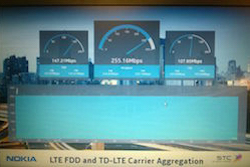Nokia and Saudi-Arabian operator STC have conducted the first trial of TDD/FDD carrier aggregation in the region using a commercial chipset.
The trial also involved aggregating new spectrum combinations of FDD 1800MHz and TDD 2300MHz frequency.
The vendor explained that the combination of 1800MHz and 2300MHz bands provided higher speed in larger areas, and while high frequencies had limited uplink coverage, TDD/FDD aggregation significantly extended LTE TDD coverage.
Nokia said the test demonstrated that operators with scarce spectrum holdings could still greatly improve LTE network capacity by combining existing resources, presenting a sizeable cost-saving opportunity by negating the need to invest in new equipment or spectrum.
Hani Dib, head of STC customer team at Nokia Networks, commented: “We believe that the optimal use of spectrum is key to satisfy ever-increasing subscriber demand for network capacity and speed.
“Our achievement with STC will encourage other operators globally to look at this kind of spectrum convergence to save costs and increase throughput.”
Nokia has recently been involved in a number of carrier aggregation projects.
Last week, the vendor claimed it had hit data speeds of 4.1Gbps using TD-LTE/FDD carrier aggregation in a trial with China Mobile and Ooredoo Qatar.
In November, Nokia saw peak data rates of over 200Mbps in a test of carrier aggregation through small cells.
The vendor has previously said that trials of carrier aggregation were key to speeding up the deployment of LTE-A networks.
Read more:
LTE-A x3 carrier aggregation on the way after successful test, claims Rohde & Schwartz
Ericsson and Qualcomm hit 450Mbps in Cat 6 carrier aggregation test



